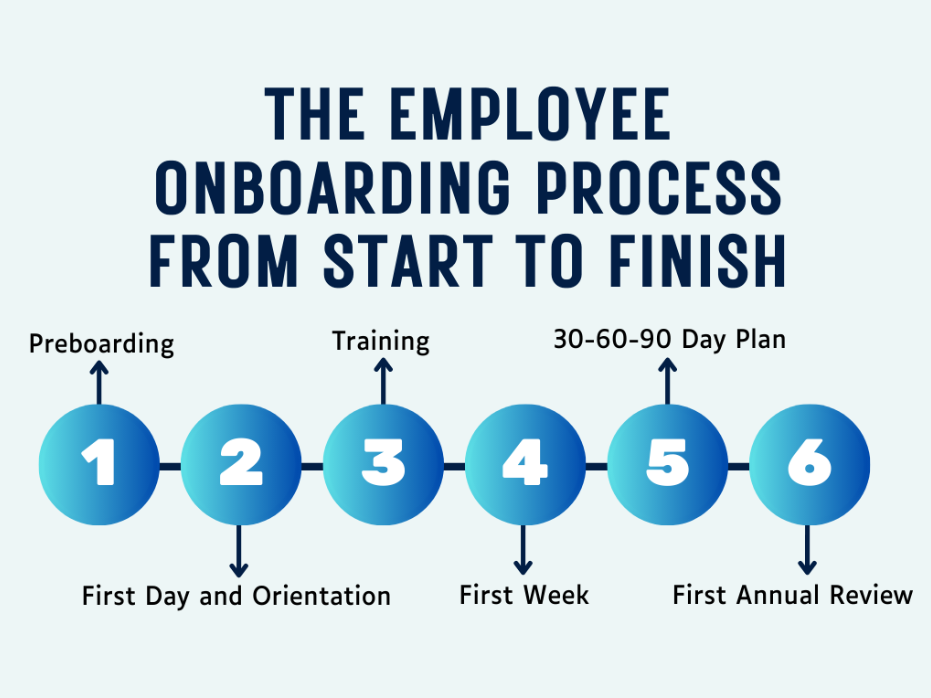New employee onboarding is the structured process of integrating new hires into your workplace. Research shows that the value of efficient onboarding goes far beyond basic paperwork and training, with employees who benefited from a strong onboarding program being up to 18x more committed to their employers.
In the age of quiet quitting, in which 85% of employees report being disengaged at work, it’s well worth investing in our employees upfront to encourage retention.
With that in mind, what does an onboarding process look like?
A comprehensive employee onboarding program will typically include preboarding, training, orientation, onboarding, and a review, and can help ensure a smooth transition for your hire and the rest of your teams.
In this article we’ll cover:
- Onboarding vs. orientation: What’s the difference?
- Why is employee onboarding important?
- What does employee onboarding look like?
- How long does it take to onboard a new employee?
- What are the benefits of a successful employee onboarding process?
- The employee onboarding process from start to finish
- Employee onboarding for remote employees
- The secret to onboarding success
Let’s get started.
What is employee onboarding?
Onboarding refers to the process of integrating your new hire(s) into your organization and preparing them for their new role.
In addition to providing a chance for hires to get familiar with their workplace, role, and coworkers, orientation also offers key contextual information about the company’s mission, vision, and values.
Onboarding vs. orientation: What’s the difference?
While onboarding and orientation almost seem interchangeable, they refer to two different yet related aspects of getting your new hires settled into their roles. While orientation refers to the process of welcoming your new employees to the company, it’s only one part of the larger onboarding process.
Orientation may span a single day or a full week depending on the role and the company in question. It often includes a series of events from lunches to keynote addresses from the CEO to presentations from each department on their work and goals. Orientation also might include the first rounds of employee training.
Onboarding, on the other hand, will typically last much longer and will involve comprehensive training, meetings, and a review process. With this in mind, you can think of orientation as just one stage in the larger onboarding journey.
Why is employee onboarding important?
Ultimately, employee onboarding is about setting your new employees up for success.
While the interview might be where your new employees get their first impressions of the organization, the onboarding process is what helps them feel confident in their decision to join the company. It’s also a great opportunity for new hires to learn more about where their role fits in in the wider company, begin the process of building relationships with coworkers, and create a solid foundation from which to grow in their careers.
In fact, according to a study from the Wynhurst Group, new employees that went through a well-organized onboarding program were 58% more likely to be at that same company three years later. That helps make the case not just for having an onboarding program, but for making it the very best it can be.
What does employee onboarding look like?
Whether you’re onboarding new employees remotely, in person, or a combination of the two, the focus is on welcoming your new hire and making sure they have the information, tech, and resources they need.
This will likely involve a combination of meetings, training sessions, and an orientation. Providing a centralized onboarding guide, whether physical or virtual, can ensure that the information your hires receive isn’t lost once onboarding is over!
In-person portions of your onboarding program foster connection and acclimate hires to your company culture. Even if your new hires will be working remotely, having at least one day of in-person onboarding can offer an invaluable opportunity for them to meet fellow new hires and existing employees face-to-face.
If it’s not feasible to offer in-person sessions, then luckily there are plenty of great digital onboarding options available for housing resources and running virtual learning sessions. Plus, we’ll offer more information on onboarding remotely later in this guide.
How long does it take to onboard a new employee?
A standard new employee onboarding timeline runs anywhere from 6 to 12 months. That might sound like a long time, but it’s important to remember that the complete onboarding process is much more than just orientation and paperwork.
Let’s take a look at the 6 steps involved.

- Preboarding: New hires sign their contracts, review paperwork, and start casually familiarizing themselves with the company’s mission
- First day and orientation: Attend meet-and-greets, learn more about the company’s values and culture, and get acquainted with the office and/or team, including getting their basic equipment set up
- First week: More thorough training, one-on-ones with teammates and management, and getting a much deeper learning of tools and systems
- 30-60-90 day check-ins: At each of these milestones, the new hire will have a goal to meet that helps them ramp up their performance and productivity by giving them clear benchmarks
- Annual review: After their first year, a progress review and goal-setting for their career trajectory
We’ll go into full detail on each onboarding stage within this timeline later on in this guide.
What are the benefits of a successful employee onboarding process?

Benefit 1: Reduced employee turnover
Businesses can experience as much as a 20% turnover rate within the first 45 days of a new hire’s employment. It can cost thousands of dollars to replace employees that quit, and that’s on top of the time and energy that was invested in training an employee who didn’t stay.
High-quality employee onboarding sets new hires up for success and can increase your chances of retaining employees long-term.
How does this work?
The way an employee perceives their onboarding experience is a reliable indicator of their long-term relationship with your organization. Underwhelming onboarding? Not the best sign for the future of that working relationship.
Good onboarding has the power to build a positive work dynamic from day one, leading your employees to feel invested in your company’s success, be more aligned with your culture and values, and feel part of a dedicated team they can trust.
Benefit 2: Increased employee productivity
Onboarding a new employee well takes time, effort, and money to achieve.
As many as 67% of employees reported an onboarding experience that was limited to a single day of orientation and training. That means instead of being able to hit the ground running, new hires have to spend valuable time tracking down the answers to their questions. This can be far more hit-and-miss than a structured onboarding program and can lead to wasted time and an inaccurate understanding of correct procedures.
What you save in time by shortening the onboarding process, you may ultimately end up losing in productivity because your new hires aren’t adequately prepared to carry out their roles.
Benefit 3: A company culture based on trust and transparency
Spelling out the company’s goals, values, and internal culture as soon as an employee is hired helps to lay the groundwork for trust.
By being transparent about what to expect and providing clear goals for an employee, employees will learn that they can trust what you say and that you’ll follow through on expectations.
Additionally, since good onboarding will involve providing regular and consistent feedback, this can serve as the start of an open line of communication. Honest communication around performance, goals, questions, and more can help to build a workspace in which your employees feel supported and capable.
Benefit 4: Increased employee engagement
Employee engagement measures an employee’s commitment to your organization and its goals, and is linked—but not identical to—employee satisfaction.
If your employees are engaged, you’re likely to notice that they appear motivated, satisfied, and passionate about the work they’re doing. They’ll be more productive, be more likely to want to engage in new projects, or go the extra mile, and you’ll see them come up with innovative solutions.
A great onboarding experience sets employees up to thrive in their workplace; it’s the first chance you as a company have to promote the type of engagement we’ve outlined above.
Benefit 5: Positive perceptions of HR and the wider organization
Onboarding is the perfect time to show new hires that they’re part of a supportive network of people who genuinely want them to succeed. By offering a detailed and thoughtful onboarding experience, your organization’s actions are communicating to new hires that their work matters and that you have their best interests at heart.
At the end of the day, building a positive company culture starts with onboarding.
The employee onboarding process from start to finish
Now that we’ve answered what an onboarding process is, let’s break down the key steps.
Step 1: Preboarding
The goal: Ensure your new hire has the information they need.
Preboarding covers the period of time before your new employee starts.
It’s common to deprioritize preboarding in favor of focusing on the all-important first week on the job, but the information you offer your new hires ahead of their first day has been proven to have a big impact on the overall onboarding experience. While 64% of new hires receive no preboarding, integrating a preboarding plan into your onboarding process can boost retention by up to 82%.
The period between accepting a job offer and starting work is crucial in terms of new hires forming opinions about the company. Offering information in advance can not only help put new hires at ease but inform their perception of the business as an organized and efficient workplace. Similarly, reaching out to extend a personal welcome can do wonders for boosting perceptions of friendliness.
Practically speaking, preboarding is the perfect time to ensure your new employees have all the information and paperwork they need, in an organized and easily understandable format. A creative and accessible way to offer this information is via a digital learning hub dedicated to your preboarding and onboarding materials.
The preboarding packet
Regardless of the format you choose, your preboarding packet should include the following:
- Offer letter
- Contract/Employee Agreement
- Statement of benefits
- Payroll information sheet
- Personal information form
- Company policies (e.g., code of conduct; diversity, equity, and inclusion; healthy and safety)
Providing this information in advance allows new hires to read and absorb this information on their own schedule, allowing them to feel prepared and enter the workspace with a clearer understanding of what is expected of them.
Preboarding tasks for employers
Preboarding is also the appropriate time for employers to carry out the following tasks:
- Purchase and prepare any equipment or technology (laptop, monitor, phone, headset, etc.)
- Set up log-in information for new accounts (computer, email, CRM, communication tools, databases)
- Arrange for building access (e.g., a fob, card, name tag, or lanyard)
- Make parking arrangements
- Prepare your employee’s physical workspace, office, or desk
Step 2: First Day & Orientation
The goal: Help your new hire feel welcome.
Your new hire’s first day and orientation can be some of the most enjoyable parts of the onboarding experience. This is the time to create a space for your hires to feel welcomed into the workspace, and to offer introductions to the team they’ll be working with.
At this stage in the onboarding process, prioritize fostering community, providing an overview of your company’s values and culture, and encouraging your new hires to feel confident about getting onboard.
On a more practical level, this is a great opportunity to introduce each of the departments, offer a luncheon or happy hour (digital or in-person) for socializing, and ensure your hires have all the equipment they need to do their job.
But remember: a great orientation is no substitute for a good overall onboarding process! While important, orientation is just one piece of the puzzle.
Step 3: Training
The goal: Equip your new hire to succeed.
Structured training programs are an invaluable part of onboarding.
Even when you’ve hired the right person for the job, a new employee is still likely to need help and guidance getting acclimated to your existing systems and SOPs. In addition, there may be new skills, tasks, and responsibilities thrown into the mix as well.
As you’re setting up your onboarding training program, aim to see it through the eyes of your new hires: this is a lot of information to take on board! Make sure to offer sufficient time for training to allow hires to pace themselves, and provide plenty of opportunities for recaps, questions, and knowledge check-ins.
Consider using the following onboarding training best practices:
- Offer bite-sized, structured training to avoid overwhelm
- Integrate a mixture of multimedia elements to engage your hires and maximize retention of the learning material
- Provide a centralized digital learning environment where hires can revisit information
- Evaluate your hires’ performance and retention to identify and correct misunderstandings early
Step 4: First Week
The goal: Help your new hire understand what is expected of them and ensure they have access to the resources they need.
Many of your training sessions will likely occur during the new hire’s first week, but that doesn’t mean it’s the only thing that should happen. Here’s a quick rundown of activities and to-dos that are a perfect fit for the first week:
- Provide access to all of the software, clearances, and access they might need to everything from Sharepoint drives to VPNs
- Set up team meetings or one-on-ones with teammates so your new hire has a chance to spend a little time with everyone they’ll be working with
- Schedule time for them to shadow employees in different departments and get a feel for the organization as a whole
- Arrange an end-of-week check-in to see how things are going and ask about any immediate roadblocks
Step 5: 30-60-90 Day Check-ins
The goal: Provide opportunities for reflection and development.
Because the onboarding process can (and should) last beyond the first week, creating a 30-60-90 plan is an important part of that process.
Within this structure, new hires benefit from scheduled check-ins at 30, 60, and 90 days into their new role, creating a clear framework for professional development.
Assigning distinct goals for each check in can help set clear expectations for new hires and offer paced opportunities for progression. Managers can track employees’ progress while offering ample opportunities for new hires to ask questions, get help, and build on their growing skillset.
Step 6: First Annual Review
The goal: Assess your new hire’s performance and set new development goals.
When employees hit their one-year mark, it’s time to do their first annual review. While annual reviews happen for all employees, not only new hires, an employee’s first annual review can be seen as marking the end of the onboarding process. It’s a great opportunity to look back and assess your employee’s growth and development over the last 12 months, and to look forward with proactive goal-setting for the year to come.
For now, you can check you’re on track with your onboarding by cross-referencing your onboarding process against our handy new employee onboarding checklist.
Employee onboarding for remote employees
What does onboarding look like for remote employees?
Thanks to technological capabilities, remote onboarding doesn’t have to look all that different from the onboarding you’ll offer to employees working on-site.
Meetings, introductions, and 1:1 sessions can all be carried out using videoconferencing software such as Zoom or Microsoft Teams, and asynchronous training materials can be easily housed in an online learning environment alongside key documents.
What are the challenges to virtual onboarding?
Virtual onboarding can present challenges, which is why it’s especially important to prioritize the preboarding tasks we outlined earlier. Equipment should ideally be delivered before an employee’s first day, so they have the time to set it up and download all necessary software in advance.
Most importantly, management and fellow team members should make sure to check in with remote employees regularly. Not seeing a coworker in person can make it more difficult for remote hires to access support or get answers to key questions they might have. Arrange to check in, even if only for a 15-minute video or phone chat, to allow remote hires to share how they’re doing.
You can check out these remote onboarding FAQs to take a proactive approach to your remote onboarding strategy.
Zoomforth: The secret to employee onboarding success
Zoomforth offers the perfect solution to centralizing your onboarding materials so you can get your new hires off to the best possible start.
Our intuitive design platform comes equipped with customizable templates to make the set-up of your online learning environment as simple as possible. Drag-and-drop tools, style guides designed to ensure brand compliance, and endless opportunities for multimedia elements and integrations make for a stunning digital onboarding platform.
To help guide new employees on their onboarding journey, you’ll have the option to choose which onboarding materials they have access to at which time. Hide and unhide materials as needed to avoid overwhelm and encourage paced learning. Once employees reach key milestones, reveal more subpages to build on their existing knowledge. The best part? All materials remain housed in a centralized location that can be accessible to employees after onboarding.
Even better? There’s no limit to how many microsites you can create, so you’re free to personalize your content to specific roles, departments, or more—without running out of space.
Rich learning experiences help contribute to employee engagement, retention, and productivity. Request a demo from Zoomforth today to get started creating the onboarding microsite your new employees deserve!



